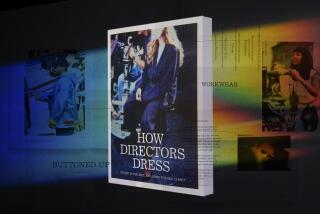Properly Dolled Up
- Share via
Ken’s been getting an eyeful for some time now: Barbie spilling out of her halter top, Barbie showing off her abs of plastic, Barbie’s long legs--inch after inch of them--stretching from her short shorts.
Monica Garcia--a new mom, longshoreman and Orthodox Jew--gives a succinct fashion critique: “Some of these dolls are dressed like prostitutes.”
Garcia hopes to give a wardrobe make-over to Barbie and her bare-midriffed friends, dressing them less like Britney Spears and more like, ah, hmm . . . that’s the problem right there, isn’t it?
So the Irvine resident has picked up her needle and thread and set out to restock the closets of Barbie dolls everywhere.
Six days a week, the 31-year-old former Catholic and single mother works as a longshoreman for the ports of Los Angeles and Long Beach. Away from the docks, Garcia runs her fledgling doll clothing company, Ms. Modesty.
From her small apartment, she dreams up patterns, sews the dresses, peddles the merchandise, ships the goods to places as far away as Israel and tends to the Web site (https://www.msmodesty.com).
She’s developed a line of 40 dresses (10 featured on the Web site), all of which reflect the Hebrew tradition of tzniut, or modesty. The clothes--dresses, shirts and blouses--cover the knees, elbows and collarbone.
So what do they show? Let’s just say they leave a lot to the imagination. And that’s quite a feat for shapely Barbie, who would measure 38-20-33 if she were human-sized.
“I just don’t want my daughter playing with dolls dressed like Barbie,” said Garcia, who converted to Judaism three years ago. “Why not try to teach modesty and values with the dolls they play with?”
Garcia launched the business last fall, but took time off to give birth to her first child, Tali, in January. Her goal is to bring in $100,000 in revenue her first year. She sold only $500 worth of doll clothes in January, due in part to her maternity leave.
“In America, she’s going after a very limited market,” said her rabbi, Joel Landau, who allowed Garcia’s clothing to be displayed at Beth Jacob Congregation of Irvine during Hanukkah. “But the market will be a very happy one. The role models that girls aspire to be are formulated in part by the toys they play with. Now little Jewish girls can dress up their dolls in a modest way.”
Roberta Carasso, a member of Garcia’s synagogue, has sent Ms. Modesty outfits to her granddaughters in Israel.
“They love the clothes, and so do their friends,” Carasso said. “They are clothes that they can’t find anywhere else.”
Barbie’s official line of outfits ranges from swimsuits to evening wear, reflecting the fashion trends of the moment. The clothes may be sassy, a Barbie spokeswoman says, but not sexy. One of the latest Barbie innovations is the flexible waist, which allows for the doll’s first bellybutton.
Garcia’s reaction: “That’s disgusting.”
Ruth Handler, the creator of Barbie and co-founder of Mattel, the manufacturer, likes the way her doll has aged over the last four decades.
“I understand Orthodox Jews, just as others, have their beliefs. That’s their privilege,” said Handler, an 84-year-old Century City resident--and Reform Jew--who is no longer involved with the toy company. “But Barbie sells more dolls and clothes than she ever did. The entire world loves Barbie very much as she is.”
The Barbie doll line brought in more than $1.5 billion in 1999, according to Mattel. On average, an American girl between the ages of 3 and 11 owns 10 Barbie dolls, company officials said.
Garcia understands Barbie’s enormous influence on little girls, which is precisely why she’s trying to get her covered up. Garcia’s dresses, shirts and tops are made with a variety of natural fabrics and feature buttons, bows and lace. The outfits cost $20 apiece, much more expensive than the official Barbie clothes, many of which cost $2 to $5.
Carasso believes the modest clothes would appeal to more people than just Orthodox Jews.
“I think the clothes would also interest the Christian world and Muslim world,” Carasso said. “It would be appropriate for any person who has some sense about life.”
But modesty wasn’t much on the minds of those who created Barbie 42 years ago.
“It’s very ironic to cover up Barbie,” said Susan Stern, director of the 1998 documentary “Barbie Nation: An Unauthorized Tour.” Barbie was created by Handler “to help young girls deal with their growing breasts and not to be embarrassed by them. To be comfortable with their bodies,” Stern said.
But, Stern added, part of Barbie’s charm is how many different lifestyles and attitudes she can reflect.
“I’ve seen people make S&M; outfits for Barbie,” Stern said. “She’s really in the eyes of the beholder. And [Garcia] is part of this wonderful Barbie world in which anyone who wants to play can play. You project your own dreams and fears onto Barbie.”






